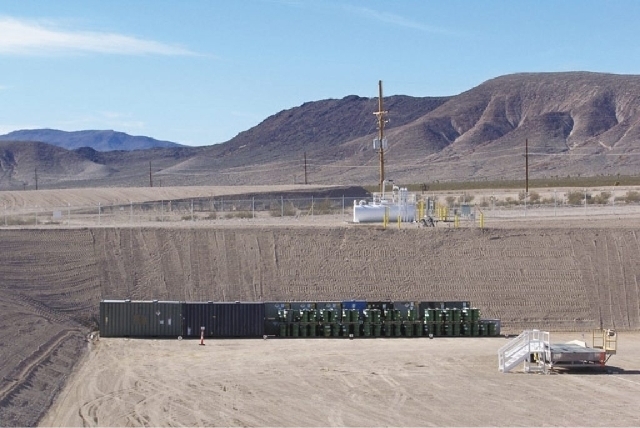Advisory board backs keeping contaminated nuclear sites in place
Rather than spend $46 million to dig up soil at the Nevada National Security Site contaminated by four nuclear tests in the 1950s and bury it in a site landfill, a community advisory board recommended Wednesday night that the Department of Energy close the tainted areas in place.
In addition to saving a lot of money that would be spent on environmental cleanup, closing and monitoring the so-called Smoky contamination area will avoid the risk of exposing workers to plutonium and other radioactive materials involved with excavating, packaging and hauling 188,000 cubic yards of soil and debris.
Removing the soil would be “a very big project,” Tiffany Lantow, the department’s lead soils activity scientist told the Nevada Site Specific Advisory Board during a meeting at the National Atomic Testing Museum.
Closing that area in place instead of disposing contaminated soil at the site’s landfill, 65 miles northwest of Las Vegas, means the Department of Energy initially will spend $72,000 with $1,500 per year for long-term monitoring and maintenance.
The board recommended the close-in-place option for dealing with the soil contamination and lead bricks and batteries that were left in the area.
A final decision on the board’s recommendation will be made by the Department of Energy in the coming months.
Much of the contamination in the northeast part of the former Nevada Test Site was caused by the Aug. 31, 1957, Smoky atmospheric nuclear weapons test, a tower shot that produced an energetic yield equivalent to detonating 44,000 tons of high-explosives.
The contamination also resulted from three low-yield weapons safety tests — Oberon, Ceres and Titania — conducted for Operation Hardtack II in October 1958.
Lynn Kidman, senior technical manager for Energy Department contractor Stoller-Navarro, told the board that because of the presence of plutonium in an area that already has restricted access would mean the measures required to protect workers involved with removing so much contaminated soil “would be extensive.”
He said that because of an agreement between the federal government and Nevada, closing the contaminated areas in place means the Department of Energy or some future federal entity will have to monitor and maintain the area “in perpetuity.”
If for some reason the land that is now under control by the Department of Energy is transferred, the government scientists will need to go back and reassess the contaminated areas for possible cleanup, Kidman said.
As of Sept. 30, the Department of Energy’s environmental team had closed 53 percent — 69 out of 130 — areas contaminated by nuclear testing and related activities in Nevada.
Contact Keith Rogers at krogers@reviewjournal.com or 702-383-0308.

















